| Collapse of the Soviet Union PDF Outline |
|---|
| www.studenthandouts.com ↣ World History ↣ Collapse of Communism ↣ Collapse of Communism PPTs |
|
I. Union of Soviet Socialist Republics a. Better known as the Soviet Union or U.S.S.R. b. Formed officially in 1922 c. Eventually contained 15 republics i. Today's Russia, Ukraine, Uzbekistan, Kazakhstan, Belarus, Azerbaijan, Georgia, Tajikistan, Moldova, Kyrgyzstan, Lithuania, Turkmenistan, Armenia, Latvia, and Estonia ii. Formed from Russia, it's former territories, and territories acquired following World War II d. Fell apart in 1991 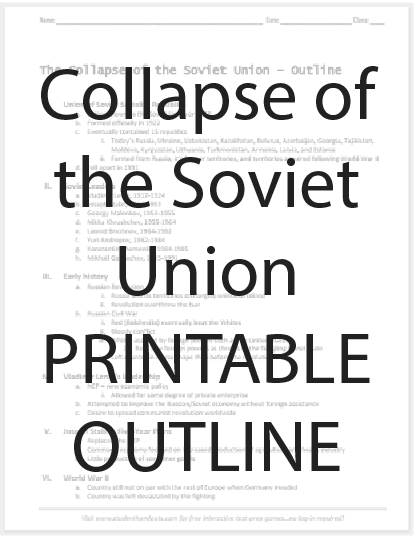 II. Soviet Leaders
II. Soviet Leadersa. Vladimir Lenin, 1917-1924 b. Joseph Stalin, 1924-1953 c. Georgy Malenkov, 1953-1955 d. Nikita Khrushchev, 1955-1964 e. Leonid Brezhnev, 1964-1982 f. Yuri Andropov, 1982-1984 g. Konstantin Chernenko, 1984-1985 h. Mikhail Gorbachev, 1985-1991 III. Early history a. Russian Revolution i. Russia and its territories still largely unindustrialized ii. Revolution overthrew the tsar b. Russian Civil War i. Red (Bolsheviks) eventually beat the Whites ii. Bloody conflict iii. Whites assisted by foreign powers such as the United States 1. Reds saw foreign powers as threats to the fledgling Soviet state iv. Left country in worse shape than before the revolution IV. Vladimir Lenin's leadership a. N.E.P.—new economic policy i. Allowed for some degree of private enterprise b. Attempted to improve the Russian/Soviet economy without foreign assistance c. Desire to spread communist revolution worldwide V. Joseph Stalin's Five-Year Plans a. Replaced the N.E.P. b. Command economy focused on increased production of agriculture and heavy industry c. Little production of consumer goods VI. World War II a. Country still not on par with the rest of Europe when Germany invaded b. Country was left devastated by the fighting i. Millions upon millions killed ii. Cities bombed beyond recognition iii. Fields and crops destroyed c. Recovery long and hard i. No outside assistance ii. Superpower iii. Had to rebuild U.S.S.R. while securing hold on Eastern Europe (iron curtain) VII. Stalin's harsh regime a. Totalitarian regime i. No freedom of speech ii. No tolerance for dissidents iii. Harsh censorship iv. Enormous amounts of propaganda v. Soviet realism in art b. Gulags—forced labor camps for "enemies of the state" i. Dissidents, undesirables, religious people, etc. VIII. De-Stalinization a. After Stalin died in 1953, Khrushchev eventually came to power b. De-Stalinization was the attempt to do away with the totalitarian remnants of Stalin's regime c. Greater freedom of speech i. For example, formerly banned books were now in print d. Many dissidents were released from gulags and prisons e. Production of consumer goods increased f. Firm control continued i. Hungarian uprising, 1956—put down by Khrushchev ii. Prague spring, 1968—put down by Brezhnev IX. U.S.S.R.'s command economy after World War II a. Soviets rebuilt their industrial base with German equipment b. Space race i. Sputnik I launched in 1957 ii. Yuri Gagarin first person in space in 1961 iii. Valentina Tereshkova first woman in space in 1963 c. Arms race i. Competition with the U.S. to have the largest arsenal 1. At the expense of manufacturing consumer goods a. Consumer goods inferior b. Luxury items very rare ii. Massive military budget 1. Many historians believe that the U.S.A. won the Cold War by outspending and bankrupting the U.S.S.R. d. Agriculture i. Collective agriculture highly unproductive ii. Soviet Union forced to import grain e. Bureaucracy i. Production levels determined by Moscow rather than by plant managers ii. Local needs not addressed f. Workforce i. Guaranteed employment ii. Little motivation to do quality work X. Soviet Union’s "Vietnam"—Afghanistan a. 1970s—Soviet Union backed a communist government in Afghanistan i. This government attempted to redistribute land according to communist ideals ii. Afghan warlords (who owned the land) fought against land redistribution b. 1979—Brezhnev sent in Soviet troops i. Warlords supported by mujahedin 1. Mujahedin—Muslim religious fighters 2. Hated the atheism of communism 3. Also opposed to foreign intervention ii. Soviet troops fought in Afghanistan for years with limited results c. 1980s—United States became involved i. Afghanistan became in some ways another "proxy war" of the Cold War ii. American government sent weapons to mujahedin such as Osama bin Laden XI. Mikhail Gorbachev's rule a. Came to power in 1985 b. Foreign policies i. Removed Soviet troops from Afghanistan ii. Signed nuclear disarmament treaties with the U.S. under President Ronald Reagan c. Domestic policies i. Glasnost—policy of openness ii. Perestroika—restructuring of the Soviet economy and government iii. Shrunk the bureaucracy iv. Allowed some degree of private enterprise v. Increased local control vi. Farmers' markets XII. Collapse of the Soviet Union a. Results of reforms i. Inflation ii. Increased shortages iii. Unemployment iv. Sparked unrest in satellite states and republics 1. 1989—Bulgaria and Poland free of Soviet control 2. 1991—Baltic states (Estonia, Latvia, and Lithuania) independent b. Failed coup d'état i. Military-backed hardliners attempted to oust Gorbachev ii. Failed, but Gorbachev still resigned iii. Remaining Soviet republics separated 1. Commonwealth of Independent States formed from several former republics 2. C.I.S. now defunct iv. No more Soviet Union XIII. Russia as an independent country a. Boris Yeltsin i. First president of Russia, 1991-1999 b. Vladimir Putin i. President, 2000-2008 c. Dmitry Medvedev i. President in 2008 ii. Putin in control as president but switching back and forth with Medvedev Click here to print. |
 |  | 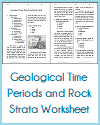 | 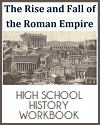 | 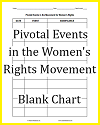 | 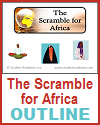 |
| www.studenthandouts.com ↣ World History ↣ Collapse of Communism ↣ Collapse of Communism PPTs |








